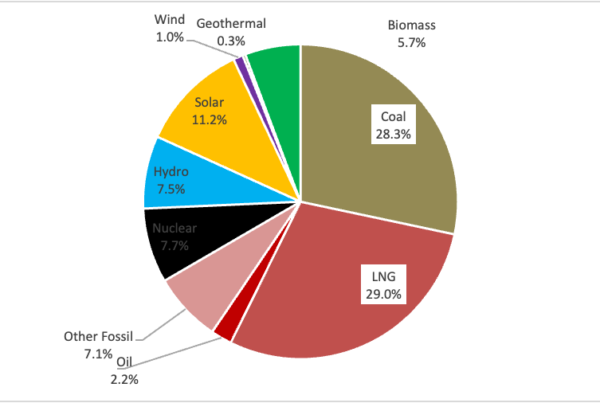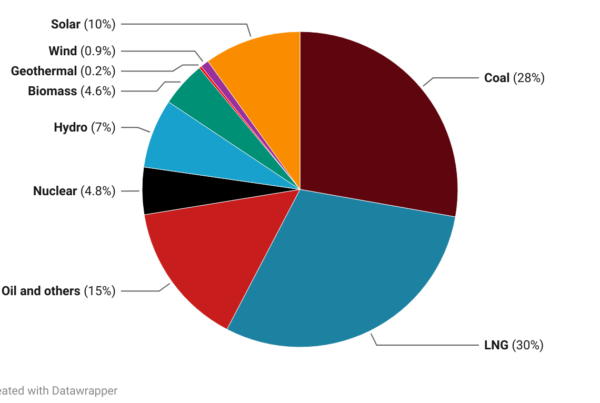”The annual share of renewable energy reaches 18%, the Solar PV to 7% of electricity generation
ISEP collected and summarized the data on renewable energy power in Japan. The preliminary report shows the share of electricity generated by renewable energy reaches 18%, the PV to 7%.
Summary
- It is estimated that the annual share of renewable energy to total power generation (including self-consumption) in Japan in 2019 (calendar year) has increased to 18.5% from 17.4% in the previous year.
- The annual share of solar PV power generation in Japan increased from 6.5% in the previous year to 7.4% in 2019, and the share of VRE (Variable Renewable Energy: Solar PV and wind power) increased to 8.2% from 7.2% in previous year.
- In 2019, share of Biomass (2.7%), Wind power (0.76%) and Geothermal power(0.24%) also tend to increase in power generation but hydro power continue to remain the same share of power generation.
- In terms of the annual share of fossil fuel generated power, the percentage has decreased from 78% in the previous year to 75%, however, this level is still high, also the nuclear power generation has increased from 4.7% in the previous year to 6.5% in 2019.
- In Europe, there are already many countries where the annual share of renewable energy power generation exceeds 30%, with Denmark reaching 84%. In many countries, the share of VRE (Variable Renewable Energy) is over 20%, with 55% in Denmark.
- Each European country has set a high medium- to long-term target for introducing renewable energy, and some countries aim to supply electricity with 100% renewable energy by 2030. Compared to these, Japan’s target 24% is very low.
- In China, renewable energy share for 26.4% of the annual total power generation, including hydropower, wind power accounts for 5.5%, solar PV power share for 3.1%, and VRE share (8.4%) greatly exceeds share (4.8%) of nuclear power.
Share of renewable energy to total power generation in Japan
Based on power survey statistics[1], FITs, and power supply and demand data for the whole country, we estimated the annual share of renewable energy to total power generation (including self-consumption) in Japan in 2019[2]. As a result, the share of total renewable energy generation in Japan in 2019 (calendar year) increased to approximately 18.5% from 17.4% in the previous year as shown in Table 1, and Figure 1.
The annual share of renewable energy, which was about 12% in 2014, reached more than 18% in 2019 with an increase of about one point each year (Figure 2). Among them, the amount of solar PV power generation has increased from 6.5% in the previous year (2017) to 7.4%. The power supply mix in FY2030 has already achieved in the share (7%) of solar PV, which assumed in The Fifth Energy Basic Plan (decided by the Cabinet in July 2018)[3] by the government. Together with the share of wind power 0.76%, the share of VRE has increased from 7.2% in the previous year (2018) to 8.2% in 2019. Regarding renewable energy other than solar power, biomass power generation (2.7%) increased by about 20% from the previous year, and wind power generation (0.76%) and geothermal (0.24%) increased by about 10% from the previous year, but hydropower was almost same share.
In each month of the year, May has the highest share of renewable energy among the year, reaching about 25.4% (Figure 3). In that month, the share of hydropower was 9.9% lower than previous year because of the amount of water discharge. However, because share of solar PV has reached about 11.7% in May, the share of Variable Renewable Energy (VRE) including PV and Wind has reached about 12.4%.
For wind power generation, the amount of power transmission by the annual power supply and demand data by all utilities is used instead of the Survey of Electric Power Statistics by METI. It should be noted that the share of solar PV power generation has a wide range of estimates, as it is about 10% larger than the annual power supply and demand data.
Fossil Fuel power generation showed a declining trend, in comparison to the previous year, 2019 has decreased from 77.9% to 75.0%, and from the year 2014, the generation has decreased 13 points but it is still at a high level. On the other hand, nuclear power generation has reached 0% in 2014 but starting in 2015, the generation has been increasing every year, although the share of nuclear power generation reached 6.5% in 2019, it is still has a lower share of power generation than the solar PV.
Table 1: Transition of the share of renewable energy to total power generation in Japan (Source: ISEP based on statistics of METI, etc.)
| Source | 2014 | 2015 | 2016 | 2017 | 2018 | 2019 | Notes |
| Hydro | 8.0% | 8.6% | 7.6% | 7.6% | 7.8% | 7.4% | Including large scale(>1MW) |
| Biomass | 1.5% | 1.5% | 1.9% | 2.0% | 2.2% | 2.7% | Including in-house power generation |
| Geothermal | 0.24% | 0.25% | 0.22% | 0.21% | 0.22% | 0.24% | |
| Wind | 0.47% | 0.50% | 0.54% | 0.61% | 0.69% | 0.76% | Electricity supply on grid |
| Solar | 1.9% | 3.0% | 4.4% | 5.7% | 6.5% | 7.4% | Including in-house power generation |
| Renewable Energy | 12.1% | 13.8% | 14.7% | 16.4% | 17.4% | 18.5% | |
| VRE | 2.3% | 3.5% | 5.0% | 6.3% | 7.2% | 8.2% | |
| Thermal (Fossil Fuel) |
87.9% | 85.7% | 83.6% | 80.8% | 77.9% | 75.0% | Coal, LNG, Oil, etc. |
| Nuclear | 0.0% | 0.4% | 1.7% | 2.8% | 4.7% | 6.5% |

Figure 1: Power supply mix of Japan (2019) Source: ISEP based on data of METI

Figure 2: Trend of the share of renewable energy to the total power generation in Japan (Source: ISEP based on data of METI)

Figure 3. Monthly Share of Renewable Energy Power Generation in Japan(2019)Source: ISEP based on data of METI
Table 2 shows the installed capacity of variable renewable energy power generation facilities in Japan at the end of 2018 and the end of 2019. The installed capacity of solar PV (AC-based connection capacity) has increased by 5.7GW from 48GW at the end of 2018 to reach nearly 54 GW at the end of 2019 (estimated by released data of TSO companies). Capacity of wind power generation has increased by 560MW to reach 4.3 GW.
Table 2: Installed capacity of variable renewable energy in Japan
(Source: “renewable energy connection status” by TSO companies)
| End of 2018 | 2019 | End of 2019 | |
| Solar PV | 48.2 GW | 5.7 GW | 53.8 GW |
| Wind | 3.8 GW | 0.56 GW | 4.3 GW |
| Share of VRE /peak Demand |
31.5% | 35.3% |
Reference
[1] Survey of Electric Power Statistics(Japanese Only) https://www.enecho.meti.go.jp/statistics/electric_power/ep002/
[2] The previous year’s figures are used to estimate the amount of self-consumption and home-use solar PV from October 2019. However, this may cause small amount of effects.
[3] 5th Basic Energy Plan https://www.meti.go.jp/english/press/2018/0703_002.html





